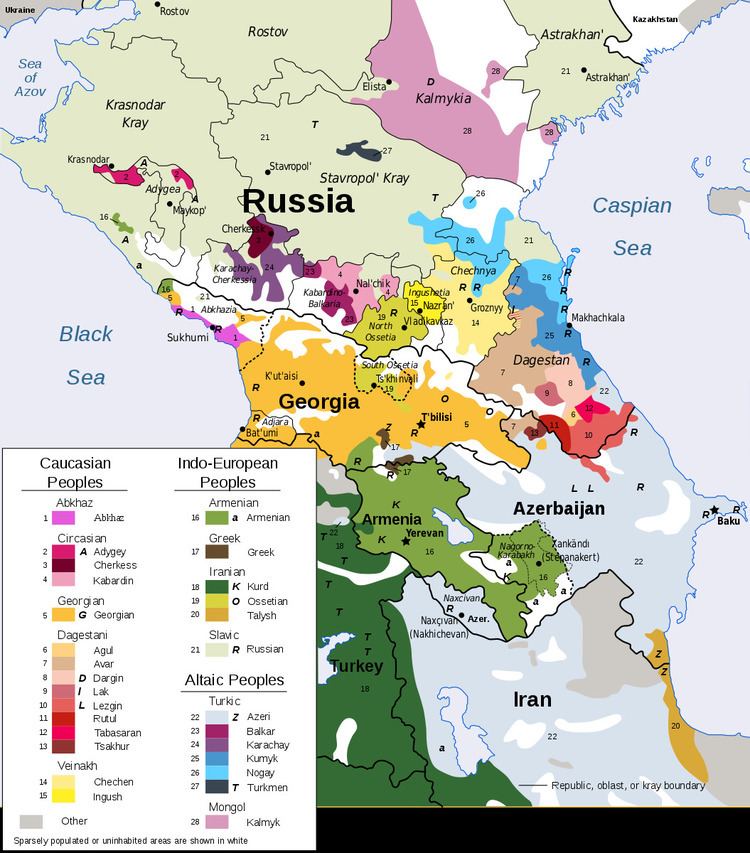Ethnicity Avars | Native speakers 760,000 (2010) | |
 | ||
Language family Northeast CaucasianAvar–AndicAvar | ||
Avar (self-designation Магӏарул мацӏ Maⱨarul maⱬ [maʕarul mat͡sʼ] "language of the mountains" or Авар мацӏ Avar maⱬ [awar mat͡sʼ] "Avar language") is a language that belongs to the Avar–Andic group of the Northeast Caucasian family.
Contents
Geographic distribution
It is spoken mainly in the western and southern parts of the Russian Caucasus republic of Dagestan, and the Balaken, Zaqatala regions of north-western Azerbaijan. Some Avars live in other regions of Russia. There are also small communities of speakers living in the Russian republics of Chechnya and Kalmykia; in Georgia, Kazakhstan, Ukraine, Jordan, and the Marmara Sea region of Turkey. It is spoken by about 762,000 people worldwide. UNESCO classifies Avar as vulnerable to extinction.
Status
It is one of six literary languages of Dagestan, where it is spoken not only by the Avar, but also serves as the language of communication between different ethnic groups.
Dialects
There are two main dialect groups: the northern, which includes Khunzakh, Kazbek, Gunib, Gumbet and others; and the southern, which includes Andalal, Gidatl', Antsukh, Charoda, Tlyarata, Tsumada, Tsunta and others.
Morphology
Avar is an agglutinative language, of SOV order.
Adverbs do not inflect, outside of inflection for noun class in some adverbs of place: e.g. the /b/ in /ʒani-b/ "inside" and /t͡se-b-e/ "in front". Adverbs of place also distinguish locative, allative, and ablative forms suffixally, such as /ʒani-b/ "inside", /ʒani-b-e/ "to the inside", and /ʒani-sa/ "from the inside". /-go/ is an emphatic suffix taken by underived adjectives.
Phonology
There are competing analyses of the distinction transcribed in the table with the length sign ⟨ː⟩. Length is part of the distinction, but so is articulatory strength, so they have been analyzed as fortis and lenis. The fortis affricates are long in the fricative part of the contour, e.g. [tsː] (tss), not in the stop part as in geminate affricates in languages such as Japanese and Italian [tːs] (tts). Laver (1994) analyzes e.g. t͡ɬː as a two-segment affricate–fricative sequence /t͡ɬɬ/ (/tɬɬ/).
Writing system
The Avar language has been written since the 15th century, in the old Georgian alphabet. From the 17th century onwards it was written in an Arabic alphabet known as ajam, which is still known today. As part of Soviet language re-education policies in 1928 the Ajam was replaced by a Latin alphabet, which in 1938 was in turn replaced by the current Cyrillic script. Essentially, it is the Russian alphabet plus one additional letter called palochka (stick, Ӏ). As that letter cannot be typed with common keyboard layouts, it is often replaced with a capital Latin letter I, small Latin letter l or the digit 1.
Orthography
The Avar language is usually written in the Cyrillic script. The letters of the alphabet are (with their pronunciation given below in IPA transcription):
History
The literary language is based on the болмацӏ (bolmacʼ)—bo = "army" or "country", and macʼ = "language"—the common language used between speakers of different dialects and languages. The bolmacʼ in turn was mainly derived from the dialect of Khunzakh, the capital and cultural centre of the Avar region, with some influence from the southern dialects. Nowadays the literary language is influencing the dialects, levelling out their differences.
The most famous figure of modern Avar literature is Rasul Gamzatov (died November 3, 2003), the People's Poet of Dagestan. Translations of his works into Russian have gained him a wide audience all over the former Soviet Union.
